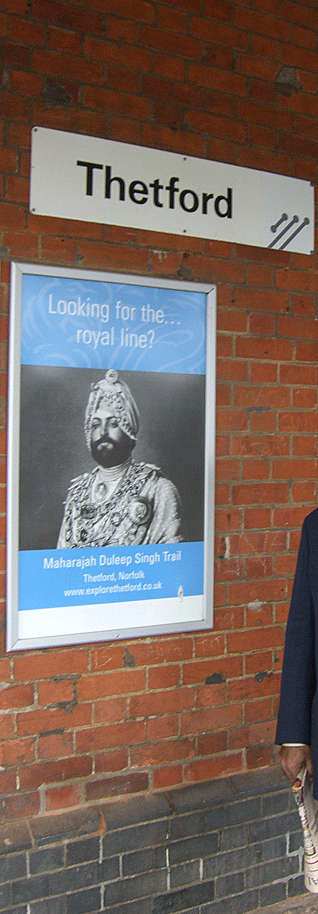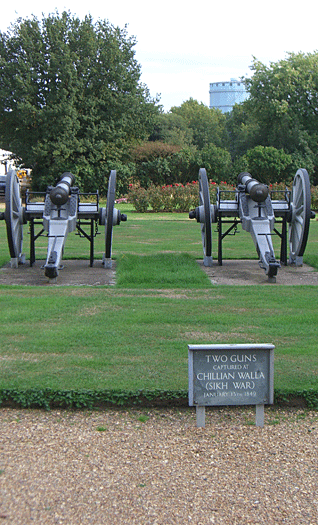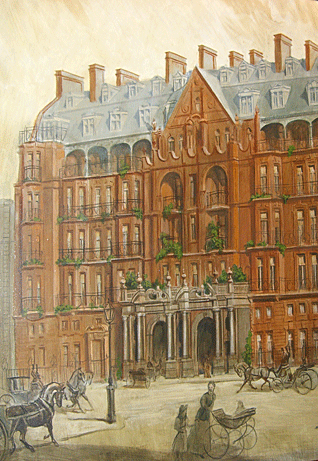
Photos by the author. Below, 1st from bottom - some of the portraiture in Osborne House. 2nd from bottom: the hotel (modern day Claridge's) where Duleep Singh was billeted when first brought to England. 3rd from bottom - Now silent Sikh guns.



Travel
A Pilgrim Through Sikh-British Heritage:
Part I
T. SHER SINGH
The following is republished from our archives:
PART I
It was a highlight of our summers when we were kids, growing up in India. And sometimes, we would set off again, either during the lengthy Dussehra holidays, or the long break around Christmas and New Year.
The whole family would somehow stuff itself into the family car - it was an Ambassador, after all! My parents, and three of us - my two sisters and I. Until later, when a brother (Artaj) came along. And then, there was the final baby of the family, a third sister: Sartaj.
Add to it all, Lal Singh, our Nepalese servant. [Or Hardyal, later; sometimes alternating with Basanti.]
And we'd head off from Patna on a totally unplanned jaunt through a new swath of India.
I remember one such trip, almost a month long, began with one of us yelling: "Dad, let's go to that dhaba where we once had those aalloo-paranthas. Oo-oh, they were so-o-o good, weren't they? Remember the full slab of butter they'd put on the top?"
So we headed north, towards Benares (modern day Varanasi), for the truck-stop we all remembered so well was just short of the teeming city.
After the mid-day feast and a long and lazy nap on the charpoys on the roadside, we sat down over a "100-mile chaa" to decide what we wanted to do next.
The last time we'd been through here, we were heading for Nainital in the Himalayan hills. The previous time, we were making a beeline for Punjab to do a full round of the historic gurdwaras ... and relatives who were to be found in virtually every town we happened to end up in on any given day!
This time, we chose Benares.
We discovered Buddha in Sarnath. And Kabir in the gullees of the old city. And gurdwaras galore that marked the comings and goings of the Sikh Gurus through the centuries. And ah yes, the burning ghats, where we stood aghast, staring into the abyss of death.
I remember this trip so vividly ... for two reasons.
I remember seeing a girl at a dinner gathering; her piercing blue eyes locked into mine. We inexplicably stole glances at each other all evening - I was but ten, she couldn't have been any older - and I fell in love. Never saw her again, but I still remember her like yesterday.
And the trip is etched in my memory for the daily delights that awaited us.
Somebody directed us to Mirzapur, famous for its carpets.
Once there, we heard about a cement factory in a place called Churak. When we stopped over to see if we could get a tour, the manager - a total stranger - took us home and hosted us for the next couple of days. And gave us a grand tour of the factory!
He pointed us in the direction of the Chunar Fort nearby.
Where I discovered the story of Rani Jindan - Maharani Jind Kaur, the youngest queen of Ranjit Singh, the Lion of Punjab, and the mother of Duleep Singh, the last Emperor of Punjab.
We were shown the cell where she'd been imprisoned, after the British had annexed the Kingdom of Punjab and sent young Duleep, the child Maharaja, into exile. I remember sitting on the mound outside the barred window of the cell as our guide related the story of her daring and dramatic escape ... she had disguised herself as a maid and managed to elude her pursuers all the way into Nepal, where she finally found refuge.
I remember asking: "Who was Duleep?" and "What happened to him?"
I can imagine the pest I would've been for the rest of the trip: "Why?" "How?" "What?" "Who?" "Where?" "When?"
The flood of questions was relentless. And Dad was a match for me: he had the answer to every question. In fact, his eyes lighted up when he talked about the rise and fall of the Sikh Empire.
And he broke into song: the only time I could stand his singing! [Strangely, oddly, my daughter holds my singing talent in the same low esteem.]
He sang verse after verse of Shah Mohammed's Vaaraan. I understood little but I found his passion and fervour infectious. How could I not be mesmerized, as I looked at his moistened eyes.
The sheer drama, the daring and the vision, the intrigue, the spectacular victories, the cataclysmic failures, the betrayals, the joys and the sorrow, the pinnacles and, oh, the depths of high adventure!
It didn't take me long to leave Flash Gordon and Jungle Jim far behind.
Over and over again during that trip, I asked him to sing ... it did something to me, even though I wouldn't know the exact words or their import until years, many many years, later.
I distinctly remember that when we got back home, the same day I penned a letter to a bookseller in Amritsar - I found the name and address in the juntree (Punjabi calendar), and a long list of fascinating titles - and ordered a dozen books in English, Punjabi and Hindi. I wanted to know everything about Ranjit Singh and Duleep Singh and Rani Jindan!
The legend of King Arthur paled into boredom, when faced with the exploits - and wisdom - of Ranjit Singh. The goings on around the Round Table were no match for the trail of the Kohinoor. Jindan easily outstripped Guinevere in both beauty and power. Lancelot had no chance against Hari Singh Nalwa or Sham Singh Attariwala or Akali Phoola Singh!
Thus began my love affair with the land of my ancestors - a land which I have had to discover slowly and in stages, first as one born and brought up a thousand miles away in an alien province, and then, a few thousand miles even further, as a Canadian struggling to stay connected to my roots.
These are the thoughts that wash over me as I sit here, on a British Airways flight: destination - London, England.
The mission: to join the inaugural Anglo-Sikh Heritage Tour which begins on Friday, July 11, 2008.
I've done this pilgrimage before ... the word comes automatically to mind. I remember Mum and Dad telling us that we Sikhs don't believe in pilgrimages, because they cannot be, and are not, a substitute for living a life of truth and service.
But, Dad would hasten to add, this - and he would wave his hand in a wide arc, as if pointing to the landscape rushing by - this is the only pilgrimage that matters: connecting with and understanding your past, meeting your heroes and honouring them, learning from past mistakes, building on past achievements ... and moving on to an even better tomorrow.
Now, ensconced in the West, far away from Punjab, like millions of us in the diaspora, our challenges remain the same.
The only difference is that now, I am behind the wheel, and our children are asking the endless questions. And I can't even sing!
The terms of reference have become finally honed, now that we're far enough to see the forest as a whole. And our lingo has changed.
Our horizon has moved further back; our world has become bigger in becoming smaller.
Looking at the new landscape we find ourselves in, literally, it is now slowly dawning on us that "Thar is gold in them thar hills!"
Take Britain, for example. Sikhs have had a long - centuries long - relationship with it.
Yes, Ranjit Singh, of course. And Duleep and Jindan. The Kohinoor. The mutiny. Baba Ram Singh Kuka. Queen Victoria. Bhai Ram Singh, the architect. Dalhousie and Lawrence (of Punjab!). Elveden. Jaito. Paisley. Gurdwara Reform. Komagata Maru. The two World Wars. Max Macauliffe. Jallianwala Bagh. Udham Singh. Gallipoli. Saragarhi. C.F. Andrews. Bhagat Singh. Partition. Independence ....
Yes, thar is gold in them thar hills.
Go North to Scotland, or all the way south to the Isle of Wight. Or East. Or West. Or in the streets and corridors of London itself. There are stones and graves, art and treasures, which record OUR history ... and each and everything is identified, catalogued and recorded, restored and preserved, honoured, protected, sometimes even displayed ... like things never have been in the sad India that we have left behind.
After we are done with our rounds in Punjab and India, introducing our children to some of our past and present, it is crucial that we then take them on a similar pilgrimage across Britain to discover our roots ... here!
[Our work is cut out for us: Once we've got started here, we need to move on to the historic Sikh towns of British Columbia, to Malaysia and Singapore, to East Africa, even Australia ...]
So, on Friday, July 11, 2008, a number of us embark on a week-long journey, starting here in the very heart of London.
I'll be back with more, every day!
Continued tomorrow ...
First published on July 9, 2008. Republished on October 10, 2014.
Conversation about this article
1: Jasvinder Singh (London, England), July 09, 2008, 6:11 PM.
How encouraging to see such an initiative at last. The U.K., and particularly London, is a tourist destination for the whole world yet Sikhs remain oblivious to the strength and depth of their history that resides here. Hope this is the first of many such tours. How can we get more information?
2: Naurang Singh (Miami, Florida, U.S.A.), July 09, 2008, 6:17 PM.
Great news. But how come it wasn't so widely advertised? We would dearly have loved to join. Please let us know the next tour dates and how we can find out more about this tour? Will any images be publicised? [There will be daily reports on sikhchic.com from today on, alongwith photographs. Future tours will be advertised well in advance on this site.]
3: Mohinder Kaur (Toronto, Canada), July 09, 2008, 6:20 PM.
Such a wonderful upralla! I would like to wish that the S.G.P.C. could have thought of something like this, but I guess I am being totally unrealistic. In any case, they're too busy destroying our heritage to have any time or interest in preserving it.
4: Pawiter Singh (Leeds, U.K.), July 09, 2008, 6:26 PM.
It is a shameful fact that our true Sikh heritage lies abandoned in Pakistan and India. We need to concentrate on doing all of this with our heritage and legacy back home.
5: Inder singh (U.S.A.), July 10, 2008, 11:46 PM.
I wish Sikhs buy the Elveden Hall estate of Maharaja Duleep Singh. That will be the ultimate tribute to the last Emperor of the Sikhs.
6: Rupinderpal Dhillon (Reigate, United Kingdom), October 10, 2014, 6:14 AM.
The estate will be too expensive for us. The powerful Guinness family own it. I went there 7 years ago, saw the statue, the museum and the graves. The locals are very proud of the history.
7: Sangat Singh (Kuala Lumpur, Malaysia), October 10, 2014, 7:55 PM.
In the year 2008 I had not yet broken into sikhchic.com. What a lovely description of your annual romps in your faithful Ambassador to take you all on those holiday/study tours. Sher ji, you didn't mention if the family dog was also included in the entourage. In our school days at Sacred Heart Convent School, Lyallpur, there used to be a book, "Highroads of English History." A handsome hard cover book with plenty of pictures that used to be a prized possession. Today, reading your Pilgrim's Progress has brought back those memories. May I rename it as "Highroads of Sikh Heritage"? After all those 70 odd years, "The Highroads of English History" has lost its sheen. In those days anything English would change your colour to something brownish white and we carried that chip on our slender shoulders. Thanks, Sher Singh ji, for taking us on that trip despite space in your faithful Ambassador. The other choice used to be the tiny Fiat -- no match for the sturdy Ambassador. After studying in India, when he returned to his first job in Singapore or Malaya, an Indian's first car was invariably a Fiat 1100. And if he was affluent enough, then he bought himself a Chevrolet, an icon that announced you had arrived. This was in the early 50's. Every film star then had one.
8: Ravinder Pal Singh Kalra (Brampton, Ontario, Canada), October 10, 2014, 10:21 PM.
The mention of the Kohinoor of course lights up every Sikh's eyes and a usual grudge against the Brits for "stealing it" from us. I felt no different when I saw it at the Tower. Of course I took a second ride on the conveyer to have another glimpse because that was my only reason for visiting that place. But soon a more practical thought entered the mind. The Brits did us a favor by bringing it to the Tower where it is secure and displayed with pride whereas had it been left behind, it would have been in the personal collection of a politician's wife or perhaps secured in a Swiss vault never to see the light of the day.


